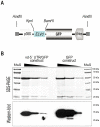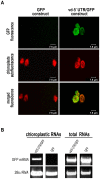Noncoding RNA mediated traffic of foreign mRNA into chloroplasts reveals a novel signaling mechanism in plants
- PMID: 20808865
- PMCID: PMC2924387
- DOI: 10.1371/journal.pone.0012269
Noncoding RNA mediated traffic of foreign mRNA into chloroplasts reveals a novel signaling mechanism in plants
Abstract
Communication between chloroplasts and the nucleus is one of the milestones of the evolution of plants on earth. Proteins encoded by ancestral chloroplast-endogenous genes were transferred to the nucleus during the endosymbiotic evolution and originated this communication, which is mainly dependent on specific transit-peptides. However, the identification of nuclear-encoded proteins targeted to the chloroplast lacking these canonical signals suggests the existence of an alternative cellular pathway tuning this metabolic crosstalk. Non-coding RNAS (NcRNAs) are increasingly recognized as regulators of gene expression as they play roles previously believed to correspond to proteins. Avsunviroidae family viroids are the only noncoding functional RNAs that have been reported to traffic inside the chloroplasts. Elucidating mechanisms used by these pathogens to enter this organelle will unearth novel transport pathways in plant cells. Here we show that a viroid-derived NcRNA acting as a 5'UTR-end mediates the functional import of Green Fluorescent Protein (GFP) mRNA into chloroplast. This claim is supported by the observation at confocal microscopy of a selective accumulation of GFP in the chloroplast of the leaves expressing the chimeric vd-5'UTR/GFP and by the detection of the GFP mRNA in chloroplasts isolated from cells expressing this construct. These results support the existence of an alternative signaling mechanism in plants between the host cell and chloroplasts, where an ncRNA functions as a key regulatory molecule to control the accumulation of nuclear-encoded proteins in this organelle. In addition, our findings provide a conceptual framework to develop new biotechnological tools in systems using plant chloroplast as bioreactors. Finally, viroids of the family Avsunviroidae have probably evolved to subvert this signaling mechanism to regulate their differential traffic into the chloroplast of infected cells.
Conflict of interest statement
Figures




Similar articles
-
Can the import of mRNA into chloroplasts be mediated by a secondary structure of a small non-coding RNA?Plant Signal Behav. 2010 Nov;5(11):1517-9. doi: 10.1371/journal.pone.0012269. Epub 2010 Nov 1. Plant Signal Behav. 2010. PMID: 21057208 Free PMC article.
-
A pathogenic non coding RNA that replicates and accumulates in chloroplasts traffics to this organelle through a nuclear-dependent step.Plant Signal Behav. 2012 Jul;7(7):882-4. doi: 10.4161/psb.20463. Epub 2012 Jul 1. Plant Signal Behav. 2012. PMID: 22751312 Free PMC article.
-
Studies on subcellular compartmentalization of plant pathogenic noncoding RNAs give new insights into the intracellular RNA-traffic mechanisms.Plant Physiol. 2012 Jun;159(2):558-64. doi: 10.1104/pp.112.195214. Epub 2012 Apr 3. Plant Physiol. 2012. PMID: 22474218 Free PMC article. No abstract available.
-
Viroids: self-replicating, mobile, and fast-evolving noncoding regulatory RNAs.Wiley Interdiscip Rev RNA. 2010 Nov-Dec;1(3):362-75. doi: 10.1002/wrna.22. Wiley Interdiscip Rev RNA. 2010. PMID: 21956936 Review.
-
Viroids: an Ariadne's thread into the RNA labyrinth.EMBO Rep. 2006 Jun;7(6):593-8. doi: 10.1038/sj.embor.7400706. EMBO Rep. 2006. PMID: 16741503 Free PMC article. Review.
Cited by
-
The Role of the Chloroplast in the Replication of Positive-Sense Single-Stranded Plant RNA Viruses.Front Plant Sci. 2018 Nov 27;9:1776. doi: 10.3389/fpls.2018.01776. eCollection 2018. Front Plant Sci. 2018. PMID: 30542365 Free PMC article.
-
What has been happening with viroids?Virus Genes. 2014 Oct;49(2):175-84. doi: 10.1007/s11262-014-1110-8. Epub 2014 Aug 28. Virus Genes. 2014. PMID: 25164861 Review.
-
Intracellular mRNA transport and localized translation.Nat Rev Mol Cell Biol. 2021 Jul;22(7):483-504. doi: 10.1038/s41580-021-00356-8. Epub 2021 Apr 9. Nat Rev Mol Cell Biol. 2021. PMID: 33837370 Free PMC article. Review.
-
mRNA Localization in Plant Cells.Plant Physiol. 2020 Jan;182(1):97-109. doi: 10.1104/pp.19.00972. Epub 2019 Oct 14. Plant Physiol. 2020. PMID: 31611420 Free PMC article. Review.
-
Hop Stunt Viroid Expression and Host Responses in Arabidopsis thaliana.Mol Plant Pathol. 2025 Apr;26(4):e70080. doi: 10.1111/mpp.70080. Mol Plant Pathol. 2025. PMID: 40151060 Free PMC article.
References
-
- Jarvis P. Targeting of nucleus-encoded proteins to chloroplasts in plants. New Phytol. 2008;179:257–285. - PubMed
-
- Lopez-Juez E, Pyke K. Plastids unleashed: their development and their integration in plant development. Int J Dev Biol. 2005;49:557–577. - PubMed
-
- Nelson N, Ben-Shem A. The complex architecture of oxygenic photosynthesis. Nat Rev Mol Cell Biol. 2004;5:971–982. - PubMed
-
- Pogson BJ, Woo NS, Förster B, Small ID. Plastid signaling to the nucleus and beyond. Trends Plant Sci. 2008;13:602–609. - PubMed
Publication types
MeSH terms
Substances
LinkOut - more resources
Full Text Sources
Other Literature Sources

